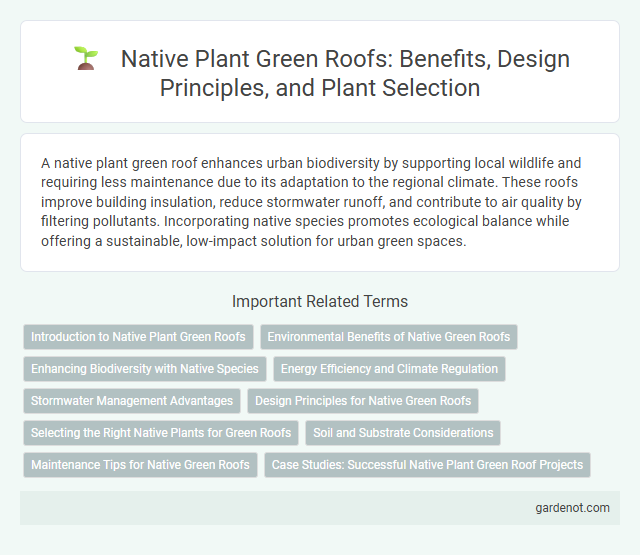A native plant green roof enhances urban biodiversity by supporting local wildlife and requiring less maintenance due to its adaptation to the regional climate. These roofs improve building insulation, reduce stormwater runoff, and contribute to air quality by filtering pollutants. Incorporating native species promotes ecological balance while offering a sustainable, low-impact solution for urban green spaces.
Introduction to Native Plant Green Roofs
Native plant green roofs utilize local, drought-resistant species to enhance rooftop ecosystems, improve stormwater management, and support urban biodiversity. Selecting indigenous plants reduces maintenance needs and promotes resilience by adapting to the specific climate and soil conditions of the area. Incorporating native flora on green roofs also aids in carbon sequestration and mitigates the urban heat island effect.
Environmental Benefits of Native Green Roofs
Native plant green roofs enhance urban biodiversity by providing habitat for local wildlife, including pollinators such as bees and butterflies. These roofs improve air quality by filtering pollutants and reducing the urban heat island effect through natural cooling processes. Stormwater management benefits are significant, as native plants absorb and retain rainfall, decreasing runoff and reducing strain on municipal drainage systems.
Enhancing Biodiversity with Native Species
Native plant green roofs significantly enhance urban biodiversity by providing habitat for local pollinators, birds, and insects. Incorporating native species supports regional ecosystems' resilience and promotes ecological balance by offering food and shelter tailored to local wildlife. These green roofs contribute to the conservation of indigenous flora while improving air quality and reducing urban heat island effects.
Energy Efficiency and Climate Regulation
Native plant green roofs enhance energy efficiency by providing superior insulation through their deep root systems and natural soil layers, which reduce heat transfer and lower building cooling and heating demands. These roofs contribute to climate regulation by promoting local biodiversity and capturing carbon dioxide, while their evapotranspiration process cools surrounding air and mitigates urban heat island effects. The use of drought-resistant native species minimizes irrigation needs, optimizing water conservation and supporting sustainable urban ecosystems.
Stormwater Management Advantages
Native plant green roofs significantly enhance stormwater management by absorbing and retaining large volumes of rainwater, reducing runoff and mitigating flood risks in urban areas. The deep root systems of native species improve soil infiltration and promote natural filtration, leading to decreased pollutant loads entering waterways. These systems also slow down runoff rates, helping cities manage stormwater sustainably while supporting local biodiversity.
Design Principles for Native Green Roofs
Native plant green roofs prioritize selecting indigenous species adapted to local climate and soil conditions, enhancing biodiversity and requiring minimal maintenance. Design principles emphasize layering substrate depth to support root systems, optimizing drainage to prevent waterlogging, and creating microhabitats to attract pollinators. Incorporating these elements ensures sustainable, resilient green roofs that contribute to urban ecosystem health.
Selecting the Right Native Plants for Green Roofs
Selecting the right native plants for green roofs enhances biodiversity and improves stormwater management by utilizing species adapted to the local climate and soil conditions. Drought-tolerant, shallow-rooted plants such as sedums, grasses, and wildflowers promote soil retention and reduce irrigation needs, optimizing green roof sustainability. Incorporating diverse native species supports pollinators and creates resilient ecosystems that thrive with minimal maintenance.
Soil and Substrate Considerations
Native plant green roofs require lightweight, well-draining substrates that replicate natural soil conditions to support root growth and moisture retention. A substrate mix often includes organic matter, sand, and lightweight aggregates to balance aeration and water-holding capacity, crucial for drought-tolerant native species. Proper soil depth and composition ensure nutrient availability and promote biodiversity while minimizing structural load on the building.
Maintenance Tips for Native Green Roofs
Native plant green roofs require minimal irrigation due to their drought-tolerant species, but regular weeding is essential to prevent invasive plants from overtaking the roof. Seasonal inspections help monitor plant health and soil moisture levels, ensuring optimal growth conditions. Removing dead foliage and replacing unhealthy plants maintain the roof's ecological balance and improve overall performance.
Case Studies: Successful Native Plant Green Roof Projects
Case studies of native plant green roof projects demonstrate enhanced biodiversity and improved stormwater management across urban environments. The Chicago City Hall green roof, featuring predominantly native species, reduced rooftop temperatures by 30% and increased pollinator activity by 40%. Another successful project in Toronto utilized indigenous sedges and grasses to decrease annual runoff by 50%, showcasing the ecological and hydrological benefits of native plant green roofs.
Native plant green roof Infographic

 gardenot.com
gardenot.com